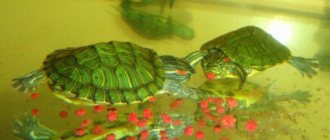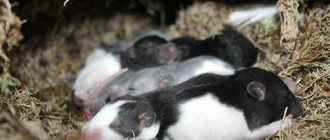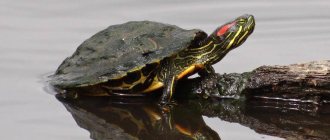The poor birth rate of this species of reptile is also explained by the incompetence of the owners regarding how red-eared turtles reproduce and the inability to create suitable conditions for this.
Determination of gender
To ensure reptiles reproduce at home, it is necessary to find out which sex each turtle belongs to. Obviously, the offspring is the result of the mating of a male and a female.
This is interesting: A female reptile can lay eggs without the participation of a male, but storing them will not give any results, since fertilization in this case was not carried out.
Sexual dimorphism in red-eared turtles appears at one year of age. For comparison, it is recommended to take reptiles of the same age. The distinction between individuals is carried out according to the following criteria:
- body size (females are larger);
- claws on the front paws (in males they are longer);
- tail (longer in males than in females);
- the shape of the lower part of the shell (in females it is flat, in boys it is concave).
Mating process in nature
First of all, it should be clarified that the genital organs of turtles are located in the tail. Therefore, the male approaches the chosen one from behind and crawls onto her back with the front part of his body. He adapts his tail under hers, directing the sexual organ to the right place.
At the end of the action, the male emits a “victory cry”. And let only his chosen one hear it, but this is the song of a winner who has achieved his goal. The female also responds to him with a “yelp.” This is how turtles mate in nature.
Conditions for mating
Reproduction of the red-eared turtle is possible subject to the optimal age for mating - individuals must be young, but at the same time have reached sexual maturity. The readiness of females to reproduce is observed at the age of five, males begin to give birth to offspring in the fifth year of life. If you keep more than two turtles at the same time, it is advisable that there is only one male among them, otherwise the males will fight for the opportunity to mate, causing injury to each other.
Pond slider
Mineral and vitamin supplements
The diet of turtles requires supplementation with minerals and vitamins. In particular, the female needs additional food supplements throughout the entire period before mating and during egg laying. This is important because it will consume large reserves of calcium to form the calcareous shells of the eggs. She also needs to supply the yolk with nutrients for the developing embryo.
To ensure that the female can produce healthy offspring, give her daily calcium carbonate in the form of limestone flour, pouring it separately from food, and special vitamins, for example, nutrobal or vionate (3 times a week).
Preparation
Getting red-eared turtles to breed in captivity is quite a difficult task. To achieve the desired result, you first need to take care of your pets’ diet. Reptile food should include vitamins and nutrients. Vitamin E is especially useful for males, as it has a positive effect on the reproductive function of animals. Calcium and phosphorus are useful for the normal course of pregnancy in females.
Before the intended mating, two turtles need to be placed in different aquariums. To create a suitable environment, it is recommended to change the water and heat it to 25 ° C. It happens that during the mating process, the male does not allow the female to come to the surface for a long time. To prevent the reptile from suffocating, the water level in the aquarium should not exceed 10 centimeters. A container with sand must be placed inside the vessel, where the female will lay eggs.
It should be located in a dry area that is easily accessible to the turtle. Please note that mating will only occur if there is soil in the aquarium. A sign indicating that the female is ready to reproduce is the reptile displaying high activity, as well as its refusal to eat.
Brief description of the order of turtles
These animals belong to the order of reptiles. They live in captivity up to 50 years. But in the natural environment they can exist about twice as many. Although there are legends that there are individuals that have reached 350 years or more. But only the lifespan of the Madagascan radiant tortoise Tui Malila is documented - 188 years. Today she is considered a long-living winner.
A distinctive feature of all types of turtles is the presence of a shell. Perhaps, thanks to him, they managed to survive, despite various disasters that occurred on our planet. After all, these creatures are very ancient.
How do turtles mate?
Large and beautiful terrarium for turtles
Home maintenance does not imply that the breeding season depends on the changing seasons of the year, so reptiles can mate at any time. According to general observations, turtles are most active from February to May. Thus, the process of mating pets is best carried out at this time.
Until the moment of copulation, reptiles engage in mating games, which can last for several days in a row. During this period, the most important thing is to create the most comfortable conditions for the animals, ensuring them complete peace. Reptiles should not be disturbed by extraneous noise, vibration or bright light. Also, you should not pick up your pets during this time.
The process of mating games is that the male touches the female’s head with his claws and brings his shell into contact with the female’s plastron. The copulation time of reptiles is no more than five minutes. Then eggs are laid.
Mating games
Turtles are no strangers to demonstrative displays of affection. Males become very active during the mating season. Many people make the mistake of considering turtles to be silent creatures. After all, males, when courting their darlings, often make sounds similar to yapping. And females have the right to express their opinion with their voice.
Usually males challenge rivals to fights. And during the period of “fighting”, weak animals can be injured and die. So it would be a huge mistake to consider turtles as calm and good-natured animals.
The male is not so loyal to his chosen one either. Seeing a female, it begins to shake its head up and down. But he does not intend to wait for her to reciprocate her feelings. Having performed a ritual dance of recognition, the male runs to the turtle and hits it hard with his head in the shell. In addition, he bites the reptile's paws until it is eventually subdued.
Caring for eggs and young
In one clutch the female leaves from 6 to 10 eggs. The diameter of each is 4 cm. The container in which the masonry is located is emptied. The eggs are very carefully transferred to the incubator without turning them over. The temperature in it should be in the region of 25-30 oC. Instead of an incubator, you can use a regular jar of sand, which should be placed next to the heating system to create optimal temperature conditions.
The period of development of the young inside the egg is 2-5 months. All this time it is necessary to maintain the established temperature indicators. As soon as the turtles are born, place them in a separate aquarium where they will be kept for a year.
Temperature conditions for turtle breeding
For successful reproduction, turtles must be in a certain temperature range, namely +25-+30° C. Maintaining this temperature is extremely important for hormonal status, the formation and maturation of sperm. In our climate zone, it is impossible to obtain the desired temperature without artificial heating. For breeding purposes, it is especially important to maintain the desired temperature range in March, April and May, since the spring months are the main period in the breeding cycle.
Species of red-eared turtles
The popularity of yellow-bellied reptiles was given not only by their attractive appearance and easy care, but also by the variety of subspecies. Among the species of red-eared turtles, the following representatives are especially in demand:
Trachemys scripta scripta – the turtles reach 27 cm in length and have a characteristic lemon spot that merges with the stripe on the neck. The plastron is yellow with spots.
Trachemys scripta elegans - grows up to 28 cm. There is a wide red stripe on the head of reptiles.
Trachemys scripta troostii - representatives stretch up to 21 cm. There is a yellow stripe and extensive chin lines on the head. There is a yellow line on each costal shield. The plastron is decorated with small black spots.
Age and selection characteristics of turtles
- Sexual maturity in turtles depends on their size. In captivity, pets have constant access to good food, so they often grow faster than their wild counterparts. In the wild, turtles may not be sexually mature or capable of producing fertilized eggs until they are 15 to 20 years old. In captivity, sexual maturity can be reached at approximately 4 - 5 years. Breeding such young turtles in captivity will certainly affect the health of the female, so breeding should be delayed until the turtle is older.
- Males often prefer larger females, so it is important to keep females of the same size in the same breeding group.
- Elderly turtles should also not be forced to mate, as their offspring may have a lot of genetic defects, and there is also a high risk of obstetric complications during laying.
Pregnancy and childbirth
After successful fertilization, it is important to take care of the conditions for laying eggs and their contents:
- Purchase a vessel with filler for future masonry. Use sphagnum moss, vermiculite or sand.
- Prepare an incubator with a temperature of 28-30 degrees and 80% humidity to keep small reptiles for the next 2-3 months.
- Enrich the expectant mother's diet with protein foods and vitamins, and also increase the usual amount of food by 2-3 times.
A change in the female’s behavior will tell you about an imminent birth:
- signs of anxiety;
- attempts to dig holes in the ground;
- increased time spent on land;
- refusal to eat.
Stimulation of turtle reproduction
Temporarily separating males and females is a technique used by experienced breeders. It consists in the fact that males are separated from females for several weeks, and then, when they are introduced to them again, the males’ interest in the opposite sex increases significantly.
For breeding land turtles, it is recommended to have at least two males per female. Since in nature males fight for the opportunity to mate with the opposite sex, it is possible to allow them to be aggressive towards each other. If there is no competitor, the male may lose interest in the female. However, in species such as the Balkan tortoise (Testudo hermmanni), the fringed tortoise (Testudo marginata), and the Turkish Mediterranean tortoise (Testudo ibera), aggression must be carefully controlled, otherwise the males of these species can cause serious injury to each other.
It is believed that one of the factors stimulating reproduction is hibernation. But it must be remembered that not all types of turtles can be hibernated. You should also properly organize the turtle's hibernation, otherwise the animal may die.
The next condition is to provide the female with a suitable place. where she can lay her eggs. Read the following article to learn how to properly arrange a place for a turtle’s nest.
Habitat
Chinese Trionix lives in Russia, the Far East, Japan, China, Vietnam, and Taiwan. Also introduced to Malaysia, Indonesia, Guam, Philippines, South Korea, Singapore, Spain, Thailand, USA (Hawaii).
Inhabits lakes and rivers with a slow flow, with sparse underwater vegetation, places with a sandy or muddy bottom and gentle banks, where it can easily get out of the water and sunbathe. The Chinese trionix spends most of its time in water or at the bottom, buried in silt or sand. It rarely comes ashore and almost never moves further than 1.5–2 m from the water.
Diet of the red-eared slider
We have come to a very important topic - how, when and what to feed our charges. Oddly enough, these are predators; not a single turtle will refuse a piece of raw meat
They also really love bloodworms and just granular food for turtles. It is necessary to mark the fish separately:
- To eliminate calcium deficiency, feed fish with bones. You don’t have to worry, everything is designed for the animal in such a way that she will never choke on a bone;
- Try to avoid fatty fish such as capelin, mackerel, sprat. In any case, don't overuse it.
Turtle eats bloodworm
It is very important that the food is varied. For example, if a turtle is raised on meat alone, it will inevitably develop rickets
With this disease, the shell of red-eared turtles softens, appetite disappears, and coordination of movements may even be impaired. They urgently need vitamin D. If left untreated, the shell will take on a dome-shaped shape under its own weight.
Advanced form of rickets in a turtle
But let's get back to food. Young individuals require more animal food; with age, it will be necessary to give preference to a plant diet. Until the age of two years, we feed once a day, not more often. After two years of age, 2-3 feedings per week are sufficient.
If possible, place food on an island so that the water stays clean longer. But, on the other hand, this is ineffective, because the turtles will still drag everything into the water.
Diseases of the red-eared turtle
The red-eared slider requires no less grooming than any other pet. They may experience the following diseases:
- Pneumonia, also known as pneumonia. The most visible symptom is that the turtle cannot dive, no matter how hard it tries. At the same time, she is lethargic and does not eat well. This happens from hypothermia. To treat, hold the turtle over the steam of a chamomile decoction, but at a distance so as not to burn it (check with your own hand). At the same time, the water in her aquarium at home should also be heated to 28 degrees;
- Eye disease. Swollen eyelids, inflamed eyes. For treatment, isolate the turtle from other animals (the disease is contagious); during the entire period of treatment, it should only be on land. You can only immerse it in warm (up to 28 degrees) water for a couple of hours, no more. Apply eye antibiotic drops to the infected eye three times a day until the disease subsides (about 3 days);
- Soft shell. Yes, you are already familiar with this disease - it is rickets. Also, the softness of the shell, but to a lesser extent, can develop from ultraviolet deficiency;
- Skin disease. Exposed areas begin to peel off. As a rule, there can be many reasons, ranging from mechanical damage, and also depends on age. But there is still a very high probability that the animal’s vitamin balance is disturbed, especially vitamin A and vitamin B. Add vitamin supplements to the diet (be sure to read the instructions before use!).
Determining the sex of an individual
We left the most interesting thing for last - how to determine whether you bought a girl or a boy? We can only find out with age: boys have longer claws on their front paws, a longer tail, and a more elongated face.
Determining gender by claws
Fun fact - when the female lays eggs, the embryos are not sexed. The mother does not have the instinct to care for the clutch; she leaves and does not return. While the turtles develop inside the egg, their sex directly depends on the air temperature - if the temperature is below 27 degrees, then the entire clutch will consist of boys, but if above 30 degrees, only girls. If the temperature is between 27 and 30 degrees, the floor will be mixed.
And remember - we are responsible for those we have tamed!
Keeping turtles at home
There are actually three options for keeping turtles:
- Free, just walking around the apartment.
- In a terrarium.
- In specially equipped enclosures.
You should choose depending on what type of turtle you are going to purchase. That is, in other words, you should find out in the store when purchasing where this species lives in nature, what they like most.
Cleaning up after a turtle is actually even easier than cleaning up after a cat, which is why there will be no difficulties in maintaining and caring for it. You should feed her only in one specific place, and not just anywhere, she must get used to it. Over time, the animal will get used to it and will come to this place when it wants to eat.
When the heating in the apartment is turned off and it becomes cool, you need to put the turtle in some kind of box at night, it will be warmer. Many species of these animals, when they freeze, become lethargic and sick, and may even die.
When cleaning the aquarium, be sure to turn off the heater, otherwise it may break, then after cleaning it must be turned on again. In order to control the temperature, it is necessary to install special thermometers, or best of all, two. Mercury thermometers cannot be used, as they are very harmful.
Terrarium
Some believe that you can keep a reptile in a regular cardboard box.
It's a delusion. In order for your pet to feel as comfortable as possible, he needs to create all the necessary conditions. For these purposes, only a terrarium with high walls (about 1 meter) can be suitable. You should pour fairly coarse sand at the bottom, and make a small canopy out of fabric or cardboard in the corner. Such living conditions are the most natural for these animals. The terrarium must be equipped with heating, ventilation and lighting systems. Since many species of turtles require ultraviolet radiation, it is recommended to install UV lamps along with conventional lamps. They should be placed at a distance of at least 60 centimeters from the location of the reptile.
Small ventilation holes should be made in the walls and on the lid of the terrarium. For aquatic turtles, you need to build a small pond at the same level as the floor. It is very useful to place young specimens of freshwater species in an aquarium with water for some time. It should be regularly replaced with fresh, settled one.
Incubation of turtle eggs
Turtle incubator diagram
While in captivity, turtles are able to lay eggs at any time of the year. For mating to occur, several males are needed to compete for the female's attention. One male will not show interest in a female. After mating, females need vitamins E and D, as well as large amounts of calcium. The female can also lay unfertilized eggs. But if you know for sure that you have both males and females, and they had the mating process, then you can try to incubate such eggs.
Turtles can also lay eggs on the floor, but it is better to build a special box for this purpose. It is important that the female is able to dig a hole in it. The substrate that is characteristic of the wild habitat of this turtle is placed in the box. This is sand or a mixture of sand, peat and sphagnum, which must be moist. The laid eggs must be quickly transferred to the incubator. It is important not to turn the eggs for the first 5-6 hours after laying, because the embryos will die. Therefore, when you take the eggs out of the substrate, draw a cross on their top or write the egg number.
To incubate eggs, you can take microwave containers, cover the cells with a layer of damp substrate (about 5 cm) and make small holes in it, then carefully place the eggs in them (without burying them). After a couple of days, you need to check whether all the eggs have survived, and remove the dead ones from the container. If fungus appears on the eggs, it must be removed using an antiseptic solution for mouth rinsing, diluting it with water, using a one-to-one ratio.
A good incubator option is a 20 liter aquarium. A heating element with a thermostat is placed in it, and several bricks are also placed. Next, the aquarium is filled with water to one third or one second of the volume. A cuvette with eggs is placed on the bricks, which should not touch the water. The temperature in the aquarium should be 25-30 °C. The incubator should be kept away from sunlight and drafts.
Before being born, a small turtle makes a hole in its shell. For about a day, while still in the egg, she feeds on the contents of the yolk sac. You cannot remove a turtle from an egg yourself! They are transferred to small aquariums, at the bottom of which a mixture of wet sand and peat is poured. Forest species of turtles do not tolerate dry air. They need the same temperature in the aquarium as adults.
Small turtles need to be fed plant foods with the addition of calcium supplements. To obtain vitamin D, they are irradiated with ultraviolet lamps.











